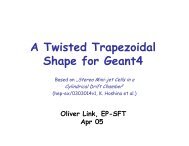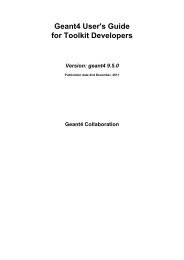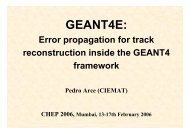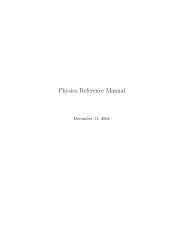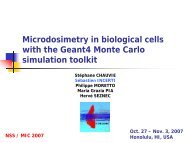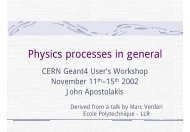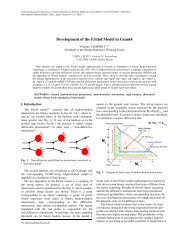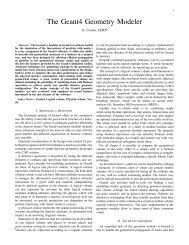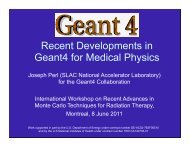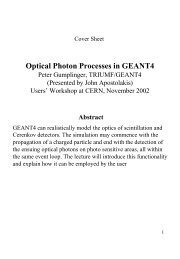A first magnetic field - Geant4 - CERN
A first magnetic field - Geant4 - CERN
A first magnetic field - Geant4 - CERN
You also want an ePaper? Increase the reach of your titles
YUMPU automatically turns print PDFs into web optimized ePapers that Google loves.
A <strong>first</strong> <strong>magnetic</strong> <strong>field</strong>First steps in <strong>field</strong> propagation in <strong>Geant4</strong>John Apostolakis11 th November 2002
Magnetic <strong>field</strong>: overview• In order to propagate a particle inside a <strong>field</strong> (e.g.<strong>magnetic</strong>, electric or both), we solve the equationof motion of the particle in the <strong>field</strong>.• We use a Runge-Kutta method for the integrationof the ordinary differential equations of motion.– Several Runge-Kutta ‘steppers’ are available.• In specific cases other solvers can also be used:– In a uniform <strong>field</strong>, using the analytical solution.– In a nearly uniform <strong>field</strong> (BgsTransportation/future)– In a smooth but varying <strong>field</strong>, with new RK+helix.11 November 2002 J. Apostolakis, <strong>Geant4</strong> UsersWorkshop, <strong>CERN</strong>3
Magnetic <strong>field</strong>: overview (cont)• Using the method to calculate the track's motionin a <strong>field</strong>, <strong>Geant4</strong> breaks up this curved path intolinear chord segments.• We determine the chord segments so that theyclosely approximate the curved path.• We use the chords to interrogate the Navigator,to see whether the track has crossed a volumeboundary.11 November 2002 J. Apostolakis, <strong>Geant4</strong> UsersWorkshop, <strong>CERN</strong>4
Stepping and accuracy• You can set the accuracy of the volume intersection,– by setting a parameter called the “miss distance”• it is a measure of the error in whether the approximate trackintersects a volume.• Default “miss distance” is 3 mm.• One physics/tracking step can create several chords.– In some cases, one step consists of several helix turns.miss distance‘Tracking’ Stepreal trajectoryChords11 November 2002 J. Apostolakis, <strong>Geant4</strong> UsersWorkshop, <strong>CERN</strong>5
Magnetic <strong>field</strong>: a <strong>first</strong> exampleCreate your Magnetic <strong>field</strong> class– Uniform <strong>field</strong> :• Use an object of the G4UniformMagField class#include "G4UniformMagField.hh"#include "G4FieldManager.hh"#include "G4TransportationManager.hh“G4MagneticField* magField= new G4UniformMagField(G4ThreeVector(1.0*Tesla, 0.0, 0.0) );– Non-uniform <strong>field</strong> :Part 1/2• Create your concrete class derived from G4MagneticField11 November 2002 J. Apostolakis, <strong>Geant4</strong> UsersWorkshop, <strong>CERN</strong>6
Magnetic <strong>field</strong>: a <strong>first</strong> exampleTell <strong>Geant4</strong> to use your <strong>field</strong>Part 2/2• Find the global Field ManagerG4FieldManager* globalFieldMgr=G4TransportationManager::GetTransportationManager()->GetFieldManager();• Set the <strong>field</strong> for this FieldManager,globalFieldMgr->SetDetectorField(magField);• and create a Chord Finder.globalFieldMgr->CreateChordFinder(magField);11 November 2002 J. Apostolakis, <strong>Geant4</strong> UsersWorkshop, <strong>CERN</strong>7
In practice: exampleN04From geant4/examples/novice/N04/src/ExN04DetectorConstruction.ccG4VPhysicalVolume* ExN04DetectorConstruct{//-------------------------------------// Magnetic <strong>field</strong>//-------------------------------------static G4bool <strong>field</strong>IsInitialized = falsif(!<strong>field</strong>IsInitialized){ExN04Field* myField = new ExN04Field;G4FieldManager* <strong>field</strong>Mgr= G4TransportationManager::GetTrans->GetFieldManager();<strong>field</strong>Mgr->SetDetectorField(myField);<strong>field</strong>Mgr->CreateChordFinder(myField);<strong>field</strong>IsInitialized = true;}11 November 2002 J. Apostolakis, <strong>Geant4</strong> UsersWorkshop, <strong>CERN</strong>8
Beyond your <strong>first</strong> <strong>field</strong>• Create your own <strong>field</strong> class– To describe your setup’s EM <strong>field</strong>• Global <strong>field</strong> and local <strong>field</strong>s– The world or detector <strong>field</strong> manager– An alternative <strong>field</strong> manager can be associatedwith any logical volume• Currently the <strong>field</strong> must accept position globalcoordinates and return <strong>field</strong> in global coordinates• Customizing the <strong>field</strong> propagation classes– Choosing an appropriate stepper for your <strong>field</strong>– Setting precision parameters11 November 2002 J. Apostolakis, <strong>Geant4</strong> UsersWorkshop, <strong>CERN</strong>9
Creating your own <strong>field</strong>Create a class, with one key method – that calculates thevalue of the <strong>field</strong> at a Pointvoid ExN04Field::GetFieldValue(const double Point[4],double *<strong>field</strong>) const{<strong>field</strong>[0] = 0.;<strong>field</strong>[1] = 0.;if(abs(Point[2])
Global and local <strong>field</strong>s• One <strong>field</strong> manager is associated with the ‘world’– Set in G4TransportationManager• Other volumes can override this– By associating a <strong>field</strong> manager with any logical volume• By default this is propagated to all its daughter volumesG4FieldManager* localFieldMgr=new G4FieldManager(magField);logVolume->setFieldManager(localFieldMgr,true);where ‘true’ makes it push the <strong>field</strong> to all the volumes itcontains.11 November 2002 J. Apostolakis, <strong>Geant4</strong> UsersWorkshop, <strong>CERN</strong>11



